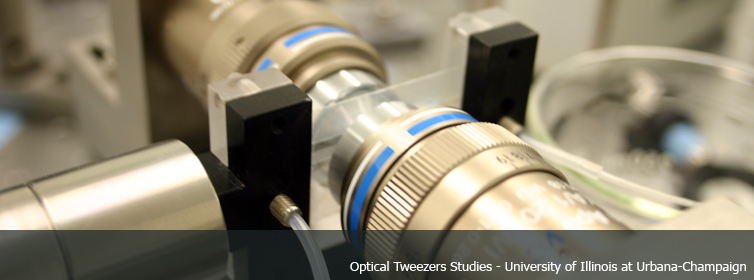
Description of Current Research
The cell is a factory of complex molecular structures that carry out specialized mechanical tasks and that behave remarkably like machines. Molecular motors, as they are called, are involved in such diverse processes as replicating the genome or transporting cargo across the cell, typically moving in discrete steps along a track — actin, microtubules, or DNA itself — converting chemical energy into mechanical work. A broad area of interest in my laboratory will be understanding the mechanism by which these molecular machines operate, and specifically, the process of mechano-chemical conversion.

Biophysical techniques that can detect such processes at the level of a single molecule are extremely powerful, since they are not subject to the averaging artifacts of traditional bulk biochemical methods. Optical traps, or “optical tweezers,” which utilize the force generated by focused laser light to manipulate microscopic objects, have been used extensively to measure the movements and forces exerted by individual molecular motors.
Recently, advances to this technique have made it possible to resolve motions on the scale of a single base pair of DNA, or only 3.4Å (see for example, Moffitt et al., PNAS, 2006). These high-resolution optical trapping techniques have the potential to reveal, for the first time, the stepwise motions of a host of molecular motors that translocate along or interact with nucleic acids and proteins. Access to this length scale should lead to a more detailed and refined understanding of many fundamental processes.
Students in my laboratory will work on all facets of research in this area: design and construction of instrumentation, development of biological systems for single-molecule manipulation, and quantitative analysis and modeling of collected data. Interested students and postdocs with backgrounds in physics, biology, chemistry, or related fields are welcome to contact me.
Since the last reporting period, my lab has constructed an ultrahigh-resolution optical trap in our environmentally controlled basement space. In February, we were able to achieve our design goal and resolve motions at the one-basepair (3.4Ångstrom) length scale. This is one of only a handful of instruments in the world capable of measurements at this resolution. Using this instrument, we have begun to take data on a variety of biological systems. Of particular note are high-resolution measurements of single-stranded DNA binding protein (SSB) interactions with DNA, and studies of bacterial chemotaxis in collaboration with Prof. Ido Golding. These experiments are already yielding publication-quality data.